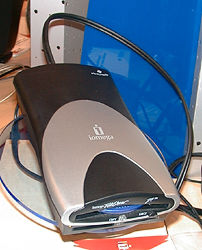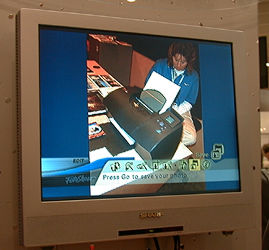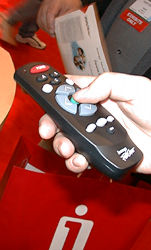| The MacWorld Expo 2001 report | |
MACWORLD EXPO GETS THE PICTURE
A Photographer Mops Up the Floor
SAN FRANCISCO -- Macworld Expo wasn't just about Apple this year. For a digital photographer, the Expo promised some real solutions to some nagging problems.But first the bad news.
Absent and Not Accounted For
The most striking difference between this year's Expo and last's was the utter absence of online photofinishers. They were plentiful last year. This year, not one.
We've heard that online advertisers are disappearing from the SuperBowl, too. Down to 10 percent from 40 percent last year. So it isn't Apple's fault.
They won't, unfortunately, know what they missed. The aisles were full -- with both exhibitors and consumers. So let's get on with the story (and the good news).
More on the G4 Powerbook
OK, we're getting used to the look of the G4 PowerBook. It no longer makes us think of Vic Damone, as we reported last time. Maybe some platinum blonde like Patty Lee (even Debbie Harry). Still can't get the reel-to-reel vs. cassette issue out of our minds, but we'll take it up with a professional.
And we learned a few things we have to pass along.
The sleep throbber is much less annoying than current lighthouse standards. A small LED near the hinge indicates the thing is not dead. You can, once again, sleep at night.
Provision has been made for a Kensington lock, padded with a rubber fitting. As if you could scratch titanium.
The keyboard does not flex (press a mid-span key on any PowerBook and watch the whole keyboard yield gracefully to pressure). It's done, somehow with magnets.
Contrary to our first day experience, we did see a G4 PowerBook wake from sleep and actually display an image or two on screen.
The latch in the screen that attaches the top to the base retracts when the screen is flipped up. As you lower the screen, a magnet in the base draws the latch out so it can secure the unit. Magnets and computers, historically, do not match. Jobs, perhaps, is exhibiting supernatural powers. Fortunately Apple is not located in Salem Valley.
The little grill on the side is actually a PCMCIA slot. We find these things essential. Can't imagine owning a laptop without one.
Inkjet Printers
Epson confined their research and development to an Airport-enabled model. Which is saying something. We're quite unamused by the network-ignorant offerings of most manufacturers. A networked printer is a wonder to behold. By everyone. And why not. What's the big deal. Build networking in. Please.
The Epson is Airport ready HP has a Send button to copy images from
the card to your computerHewlett-Packard had an interesting alternative. Their Photosmart 1000 doubles as a card reader (both SmartMedia and CompactFlash). Their "smart" printers are eminently affordable at $299, considering.
The HP demonstrator swore on a stack of manuals that the new models need just two sets of cartridges a year and will not dry out from infrequent use (well, her afterlife was at stake). Be wary, though, she warned us, of using any cartridge beyond its expiration date because the chemical stability of the inks is compromised.
Inset shows LCD displaying
progress bar for one printKodak showed a much slower (1200x1200 resolution takes a long time) Lexmark printer but it had an LCD preview so you can actually see what you're doing. Not a bad idea, but it doesn't double as a card reader.
Oh yes, they all made gorgeous prints.
Storage
We'd hoped to find the answer to the real Holy Grail of digital imaging: non-computer based storage. But the storage guys haven't caught on yet. They don't think we need a gigabyte of storage to move images from our CompactFlash, SmartMedia or Memory Stick while we are vacationing in exotic locales like their customer support queues (where we've spent many a vacation).
Odd but we saw no support whatsoever for Memory Sticks.
Iomega did introduce the USB/FireWire/SCSI Peerless drive which uses an IBM microdrive in a housing that clicks into a cradle that contains the hard drive electronics. But they were thinking TiVo and auto CD players, not digicam users.
And La Cie had their Pocket Drive on display, but the same problem. These things need a host to work.
Where's the mass storage device that can slurp up data untethered from a laptop?
The closest thing we could find was the Iomega FotoShow. This happens to make remote, independent storage possible, but that's not really its thing (or it would be smaller and come without a remote control). Its thing is to provide slide shows and limited image editing (licensed from Adobe) to anyone who has a television. Both S-Video and RCA connectors are provided for output. Input is managed using either a USB connection to a computer or, at the other end of the box, a Zip disk, SmartMedia or CompactFlash cards.
 |
 |
 |
| The FotoShow box itself | Menus on your TV screen | The Remote Control |
You need PC-formatted Zip disks to use it untethered, but once you pop your camera's card into the thing it copies the images to the Zip, which also functions as a standard Zip 250-MB drive when attached to a computer.
It's a bit bulkier than a Zip drive (that broadcasting gear) and it adds yet another remote control to your collection (to navigate the image editing and display options on your television screen), not to mention another power adapter, but it will allow you to leave your laptop at home. Of course, if you happen to have G4 laptop, that's probably a disadvantage.
We poked around the SanDisk booth (Lexar was missing in action) and the tiny Microtech booth. There seems to be a lot of confusion about CompactFlash and it seems to be growing. At the Microtech booth we learned that their CF5 designated cards sport a faster onboard controller (and are consequently more expensive). So you have to watch not only the brand but the model these days. In fact, we suspect there's more difference between models than brands.
Color Calibration
You wouldn't know it to read through the newsletter archive, but we are rabid about the subject of color calibration. While it's easy to appreciate the problem of trying to get predictable, repeatable, reliable results with uncalibrated devices and fickle mediums, it isn't very easy (or inexpensive) to deal with it. Let alone explain what's going on.
But we saw a couple of approaches to the problem at the Expo that held some promise. Especially since they cost less than $500 to implement.
One of them is an oldie. What photographers have been doing since the darkroom was invented in a cave somewhere. It's Vivid Details' Test Strip plug-in using Adobe's plug-in architecture. Test Strip has been around a while, too, but version 3.0 is just about out the door.
This cross-platform plug-in (which uses separate code bases for each product) seems to mix a more powerful version of Photoshop's Variations command with PhotoGenetics color correction technique (which it calls "metamorphosis").
Metamorphosis color corrects an image according to your personal color preference while "eliminating opposing transformations that can lead to image degradation." It does it by asking you to pick the better of two versions of the image (like PhotoGenetics).
Also new in version 3.0: "gels" which help preview and remove color casts; a step and repeat option to show the whole image or portions of it in each test sample; corrections isolated to highlight, midtone or shadow values; and a "one minute perceptual matching system" which includes a digital calibration page for printer output.
There's a lot going on in Test Strip and we hope to review it shortly. Upgrades are $49.95.
For a completely different (but still affordable) approach, ColorVision provides both a hardware and a software solution. To calibrate your monitor, ColorVision provides a USB device called the Monitor Spyder to read your monitor's output and PhotoCal software to create a custom ICC profile for your monitor.
The next trick is to create an ICC profile for your printer. Using ColorVision's Profiler RGB software, you print a test pattern, wait a while for the ink to dry (about half an hour for your garden variety inkjet with dye-based inks) and scan it on your scanner. The results are compared to create the profile. You can also tweak the profile to your liking using Profiler.
The process is fast and convenient enough that you can create 10 variations of a profile in under a minute, according to the company. Which isn't as silly as it might sound. Every different kind of paper you use requires a different profile -- and when you change inks, yep, you should create a new profile.
Best part of all is the price. Each of these products sells for $199. We'll take an in-depth look when the evaluation unit arrives, but we're very excited about being able to build our own profiles inexpensively.
Slide Scanning
Nikon isn't shipping them until March 1, but they have a dynamite lineup of new Coolscan film scanners. Unfortunately they had a miniscule booth, so our picture isn't pretty (the guy we were standing on kept shaking) but it does prove they've had the badges silkscreened. Which is the important part of the manufacturing process.
The low-end model Coolscan IV ED sports a USB interface, 2900 dpi resolution, a 3.6 dynamic range, scanning a 35mm frame in 35 seconds for a 35-MB file in 24-bit color or a 70-MB file in 36-bit color. For $895.
The 4000 ED The mid-range Coolscan 4000 ED provides a FireWire interface, 4000 dpi resolution, a dynamic range 4.2 with file sizes of 65 and 128-MB depending on bit depth but the same 35 second scan time for a 35mm frame. It also adds multi-sample scanning (from 2 to 16 times) to reduce noise. For $1,695.
The high-end Coolscan 8000 ED is the 4000 built for film formats larger than 35mm. It sells for $2,995.
All with Digital ICE, ROC and GEM to automatically remove scratches, correct color and remove grain.
Imaging Software
Easily the most impressive demo (but it was just a demo, folks) was Pixologic's ZBrush. Quit thinking in Photoshop 2D and work in 3D, ZBush teases. Talk lighting. Talk multiple light sources. Talk mapping textures. The product is too new to rave about, but you can find out for yourself Jan. 15 when version 1.1 is released for both Mac and Windows in a 6.5-MB download.
ACDSee is to be commended at least for taking the floor. We spoke to the developer who was chagrined to hear us ask if the asset manager could read and display Exif data. It was the most frequently requested feature (the exposure metadata stored in your image's JPEG header) he'd encountered at the show. Everybody asked about it.
And well they should, now that Canto and Graphic Converter display and handle that data (along with Cameraid). If you want to play in this league you have to swing the bat. But we didn't see any power in their warm-up cuts. The product has a completely different code base than its Windows version but doesn't seem mature enough to play with the big boys on this platform. Yet. We'll investigate it a bit more thoroughly and report back later.
ArcSoft brought their suit of cross-platform imaging software to the show, too. We haven't had a chance to explore them all yet but we can tell you what they do: printing imposition (print four images on a sheet, say), asset management, panorama stitching, simple image editing with templates and more.
Cameras? What Cameras?
The usual culprits were there: Nikon, Canon, Olympus, Kodak. We only hope the staff manning the booths were properly innoculated. There were hoards of people trying to get their hands on the current generation of digicams, a few of whom might be described as rabid. We'd have taken a picture but we didn't bring that many model releases with us.
Back to School
We must have been scratching our head when we were suddenly surrounded by a team of perky academics from R/com's MediaSchool which, for a limited time, is making their online curriculum available at no charge. Rush over to see what you can learn.
We were also pleased to see that the respected San Francisco State University multimedia studies program has an online venture at http://www.sfsuonline.org where you can enroll for $450-$650 to learn about everything from HTML to Photoshop and Web Video.
Or you could keep reading us. At these attractive prices.




